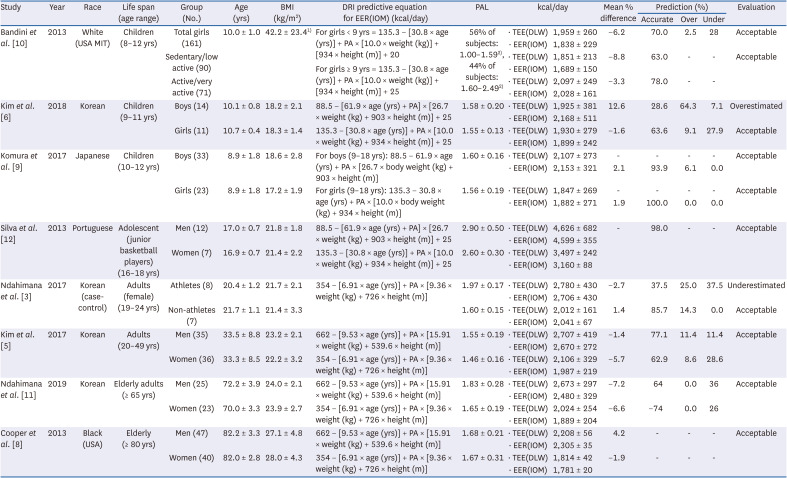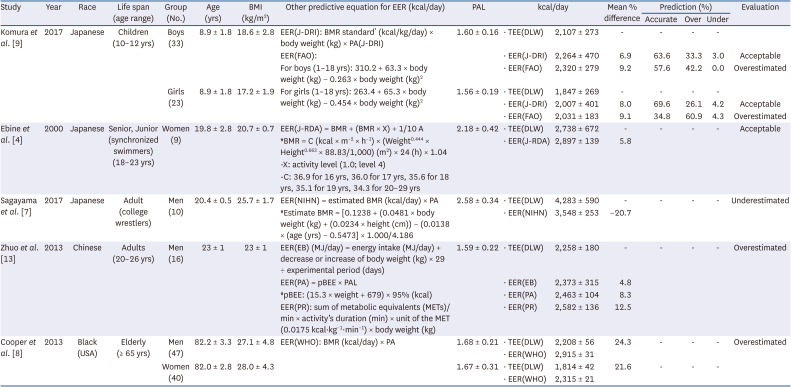1. Hill JO, Wyatt HR, Peters JC. Energy balance and obesity. Circulation. 2012; 126:126–132. PMID:
22753534.
2. Institute of Medicine. Dietary Reference Intakes for Energy, Carbohydrate, Fiber, Fat, Fatty Acids, Cholesterol, Protein, and Amino Acids. Washington D.C.: The National Academies Press;2005. p. 107–264.
3. Ndahimana D, Lee SH, Kim YJ, Son HR, Ishikawa-Takata K, Park J, Kim EK. Accuracy of dietary reference intake predictive equation for estimated energy requirements in female tennis athletes and non-athlete college students: comparison with the doubly labeled water method. Nutr Res Pract. 2017; 11:51–56. PMID:
28194265.
4. Ebine N, Feng JY, Homma M, Saitoh S, Jones PJ. Total energy expenditure of elite synchronized swimmers measured by the doubly labeled water method. Eur J Appl Physiol. 2000; 83:1–6. PMID:
11072766.
5. Kim EK, Kim JH, Kim MH, Ndahimana D, Yean SE, Yoon JS, Kim JH, Park J, Ishikawa-Takata K. Validation of dietary reference intake equations for estimating energy requirements in Korean adults by using the doubly labeled water method. Nutr Res Pract. 2017; 11:300–306. PMID:
28765776.
6. Kim EK, Ndahimana D, Ishikawa-Takata K, Lee S, Kim H, Lim K, Lee IS, Tanaka S, Kim YJ, Choi YJ, et al. Validation of dietary reference intakes for predicting energy requirements in elementary school-age children. Nutr Res Pract. 2018; 12:336–341. PMID:
30090171.
7. Sagayama H, Hamaguchi G, Toguchi M, Ichikawa M, Yamada Y, Ebine N, Higaki Y, Tanaka H. Energy requirement assessment in Japanese table tennis players using the doubly labeled water method. Int J Sport Nutr Exerc Metab. 2017; 27:421–428. PMID:
28530485.
8. Cooper JA, Manini TM, Paton CM, Yamada Y, Everhart JE, Cummings S, Mackey DC, Newman AB, Glynn NW, Tylavsky F, et al. Longitudinal change in energy expenditure and effects on energy requirements of the elderly. Nutr J. 2013; 12:73. PMID:
23742706.
9. Komura K, Nakae S, Hirakawa K, Ebine N, Suzuki K, Ozawa H, Yamada Y, Kimura M, Ishii K. Total energy expenditure of 10- to 12-year-old Japanese children measured using the doubly labeled water method. Nutr Metab (Lond). 2017; 14:70. PMID:
29167695.
10. Bandini LG, Lividini K, Phillips SM, Must A. Accuracy of dietary reference intakes for determining energy requirements in girls. Am J Clin Nutr. 2013; 98:700–704. PMID:
23885044.
11. Ndahimana D, Go NY, Ishikawa-Takata K, Park J, Kim EK. Validity of the dietary reference intakes for determining energy requirements in older adults. Nutr Res Pract. 2019; 13:256–262. PMID:
31214294.
12. Silva AM, Santos DA, Matias CN, Minderico CS, Schoeller DA, Sardinha LB. Total energy expenditure assessment in elite junior basketball players: a validation study using doubly labeled water. J Strength Cond Res. 2013; 27:1920–1927. PMID:
22990574.
13. Zhuo Q, Sun R, Gou LY, Piao JH, Liu JM, Tian Y, Zhang YH, Yang XG. Total energy expenditure of 16 Chinese young men measured by the doubly labeled water method. Biomed Environ Sci. 2013; 26:413–420. PMID:
23816574.
14. Lifson N, Gordon GB, McCLINTOCK R. Measurement of total carbon dioxide production by means of D2O18. J Appl Physiol. 1955; 7:704–710. PMID:
14381351.
15. Weir JB. New methods for calculating metabolic rate with special reference to protein metabolism. J Physiol. 1949; 109:1–9. PMID:
15394301.
16. Speakman JR. The history and theory of the doubly labeled water technique. Am J Clin Nutr. 1998; 68:932S–938S. PMID:
9771875.
17. Westerterp KR. Doubly labelled water assessment of energy expenditure: principle, practice, and promise. Eur J Appl Physiol. 2017; 117:1277–1285. PMID:
28508113.
18. Park J, Kazuko IT, Kim E, Kim J, Yoon J. Estimating free-living human energy expenditure: practical aspects of the doubly labeled water method and its applications. Nutr Res Pract. 2014; 8:241–248. PMID:
24944767.
19. Wong WW, Roberts SB, Racette SB, Das SK, Redman LM, Rochon J, Bhapkar MV, Clarke LL, Kraus WE. The doubly labeled water method produces highly reproducible longitudinal results in nutrition studies. J Nutr. 2014; 144:777–783. PMID:
24523488.
20. Lee SJ, Kim HR. Total energy expenditure of professional soccer players measured by the doubly labeled water method. Korean J Exerc Nutr. 2003; 7:241–246.
21. Yoon JS, Kim EK, Kim JH, Kim MH. Energy Expenditure Using the Doubly Labeled Water Method: Estimation of Resting Energy Expenditure and Physical Activity. 2nd Year Report. Cheongju: Korea Centers for Disease Control and Prevention;2013.
22. Wang X, You T, Lenchik L, Nicklas BJ. Resting energy expenditure changes with weight loss: racial differences. Obesity (Silver Spring). 2010; 18:86–91. PMID:
19478786.
23. Ministry of Health and Welfare (KR), The Korean Nutrition Society. Dietary Reference Intakes for Koreans 2005. Seoul: Ministry of Health and Welfare;2005.
24. Ministry of Health and Welfare (KR), The Korean Nutrition Society. Dietary Reference Intakes for Koreans 2010. Seoul: Ministry of Health and Welfare;2010.
25. Ministry of Health and Welfare (KR), The Korean Nutrition Society. Dietary Reference Intakes for Koreans 2015. Sejong: Ministry of Health and Welfare;2016.
26. Ministry of Health and Welfare (KR), The Korean Nutrition Society. Dietary Reference Intakes for Koreans 2020. Sejong: Ministry of Health and Welfare;2020.
27. Ministry of Health, Labour and Welfare. Report on the Dietary Reference Intake for Japanese. Tokyo: Ministry of Health, Labour and Welfare;2019.
28. Sogabe N, Sawada SS, Lee IM, Kawakami R, Ishikawa-Takata K, Nakata Y, Mitomi M, Noguchi J, Tsukamoto K, Miyachi M, et al. Weight change after 20 years of age and the incidence of dyslipidemia: a cohort study of Japanese male workers. J Public Health (Oxf). 2016; 38:e77–e83. PMID:
26199305.
29. Ministry of Health, Labour and Welfare, National Institute of Health and Nutrition. Seminar on Dietary Reference Intake. Tokyo: Ministry of Health, Labour and Welfare;2004. p. 4–6.
30. Energy Committee. 2020 Dietary Reference Intake for Koreans (KDRI). Seminar on the Establishing Estimated Energy Requirement of 2020 KDRI. Seoul: Energy Committee;2019.
31. Ishikawa-Takata K, Naito Y, Tanaka S, Ebine N, Tabata I. Use of doubly labeled water to validate a physical activity questionnaire developed for the Japanese population. J Epidemiol. 2011; 21:114–121. PMID:
21258166.






 PDF
PDF Citation
Citation Print
Print



 XML Download
XML Download